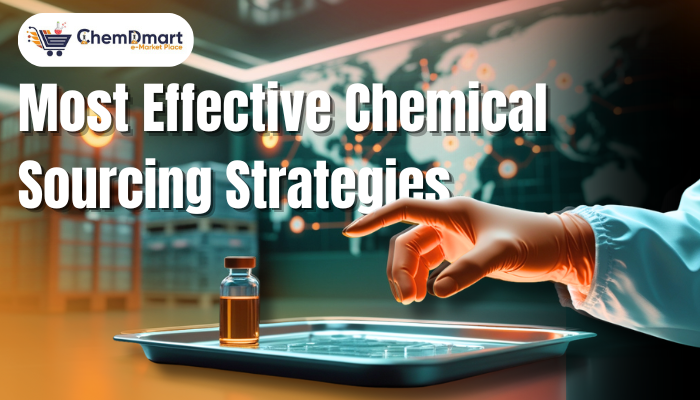
Sourcing is no longer only supplier selection; it is building reliable, compliant, cost-effective supply pipelines. Global supply disruptions, stricter regulations, and rising input costs have made sourcing a strategic priority.
Today, procurement teams must balance risk, price, quality, and compliance simultaneously.
Documentation and audit trails must be available before orders are placed. A thoughtful chemical sourcing strategy reduces delays, lowers total cost of ownership, and protects product integrity.
This post breaks down the core pillars, common mistakes, and practical fixes for procurement leaders. We will also explain how digital marketplaces like ChemDmart speed qualification, consolidate documentation, and add traceability. Read on for an actionable guide to turn sourcing into a competitive advantage.
Recently, chemical sourcing and procurement is facing drastic changes. For starters, there’s volatility, regulation and digital disruption. But these changes are also the ones that are now forcing companies to shape new strategies, and logistics.
Around 2024, Global shipping delays were around 20 days. As a result, lead times extended to 79 days on average. COVID-19, geopolitical tensions and the delays in shipping is what caused these delays. These shipment delays are the key reasons for the current fragile state of the supply chain.
Pharmaceuticals and biotechnology sectors are highly regulated and multi-layer of compliance is required in these sectors. If there is any failure in meeting safety audits or any certificate requirements, there could be delays in inspection, or worst case scenario could be bans
Ensuring traceability, documentation, and audit-ready procurement has become essential for sourcers.
With the rise of digitalization, conventional brokers and manual procurement is now losing its significance. If we talk about stats, then it has been projected that by 2032, the chemical sourcing platform market will grow from $1.2 billion to $3.08 billion which is a CAGR of 12.5%.
Online chemical B2B marketplace such as ChemDmart and other platforms to sell bulk chemicals online are replacing the old-school trade methods with transparent and digital workflows.
One key takeaway from this is: supply chains are no longer just about shipping chemicals, there’s an array of risks that comes with it. Resilience, compliance, and digital tools are rising at a fast pace and they have shifted from being an option to necessity that build the foundation of chemical supply chain.
Most of the business out there are making very common mistakes while sourcing pharma ingredients. A smart chemical sourcing strategy is built on four non-negotiable pillars. Each protects your operations from risk while delivering impact.
Supplier qualification isn’t a formality—it’s a cornerstone. Audits, GMP/IPEC compliance, and traceability are essential. Without them, you gamble on quality.
When you are sourcing pharma ingredients and raw materials, the worst choice would be going for the cheapest option. This tendency often fires back later. Here’s what you should consider:
We have already discussed, how there’s a requirement for multi-layer compliance in the pharmaceutical industry. Ignoring such important step and documentation will lead to delays in future.
Certificate of analysis, MSDS, DMFs, and import/export permits needs to be verified before purchase. Your RFQ and onboarding workflows needs to be embedded with documentation requirements.
Following good practices for distribution is utmost important. The logistics needs to ensure that ingredients do not degrade before they come into use. Here’s what can be done:
|
Pillar |
Importance |
How to Fix |
|
Supplier qualification |
Avoids supply failures and regulatory risk |
Audit and approve suppliers systematically |
|
Cost vs. Value |
Saves money beyond the invoice |
Map total cost of ownership |
|
Documentation and Compliance |
Prevents holds, recalls, and inspection issues |
Embed doc checks early |
|
Logistics and Good Distribution Practices |
Protects product integrity during transit |
Use GDP-certified partners |
Also Read: “Formulator’s Guide to Vetting Excipient Manufacturers”
The rules of sourcing are changing fast. Smart teams are already adopting new tools and approaches to stay ahead. Below are three trends that will define chemical sourcing strategy in the next five years.
AI and machine learning are being used to forecast demand and spot shortages before they happen. Forecasts are now based on sales, lead times, and external signals like weather and trade flows.
Regulators and customers are demanding greener, more ethical supply chains. Sourcing decisions are increasingly judged on carbon footprint and material life cycle.
Digital B2B marketplaces are replacing slow, broker-driven procurement for many chemicals. These platforms offer standardized data, verified suppliers, and faster RFQ cycles.
Adopting these trends will make your chemical sourcing strategy resilient, compliant, and future-ready.
You Might Also Like: “Top Challenges in Pharmaceutical Raw Materials Sourcing”
Sourcing is no longer mere procurement; it’s a strategic capability that determines quality, speed, and regulatory compliance. A robust chemical sourcing strategy prevents delays, reduces cost, and protects patient safety.
ChemDmart makes this achievable by listing verified suppliers and consolidating certificates, COAs, and provenance on one platform. Traceability is improved, RFQs are streamlined, and procurement teams are freed from manual chasing.
When sourcing is treated strategically, supply chains become resilient and launches become predictable.
Explore ChemDmart and transform your chemical sourcing into a strategic advantage
